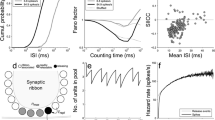Abstract
The human auditory system excels in the detection of signals in background noise. We evaluate the principles of robust processing with a detailed inner ear model and a model of octopus neurons in the cochlear nucleus. These neurons reject steady-state excitation and fire on signal onsets with extremely high temporal precision. Spike-triggered reverse-correlation analysis revealed that octopus neurons fire preferentially if many coincident spikes follow a short interval of relative low excitation. The frequency spectrum of the reverse-correlation revealed that octopus neurons perform a band-pass analysis of the incoming signal, with the pass-band ranging from about 110 to 650 Hz. The low-frequency slope was approximately 6 dB/oct, which indicates that octopus neurons process the first derivative of the input signal. This mechanism not only removes steady-state activity, which accentuates onsets, but also enhances amplitude modulation in the frequency region predominant in speech.
Preview
Unable to display preview. Download preview PDF.
Similar content being viewed by others
References
Ferragamo, M.J., Oertel, D.: Octopus cells of the mammalian ventral cochlear nucleus sense the rate of depolarization. J. Neurophysiol. 87, 2262–2270 (2002)
Holmberg, M., Hemmert, W.: An auditory model for coding speech into nerve-action potentials. In: Proceedings of the Joint Congress CFA/DAGA, pp. 773–774 (2004)
Meddis, R., O’Mard, L.P., Lopez-Poveda, E.A.: A computational algorithm for computing nonlinear auditory frequency selectivity. J. Acoust. Soc. Am. 109, 2852–2861 (2001)
Oxenham, A.J., Shera, C.A.: Estimates of human cochlear tuning at low levels using forward and simultaneous masking. J. Assoc. Res. Otolaryngol. 4, 541–554 (2003)
Lopez-Poveda, E.A., Plack, C.J., Meddis, R.: Cochlear nonlinearity between 500 and 8000 Hz in listeners with normal hearing. J. Acoust. Soc. Am. 113, 951–960 (2003)
Rothman, J.S., Manis, P.B.: The roles potassium currents play in regulating the electrical activity of ventral cochlear nucleus neurons. J. Neurophys. 89, 3097–3113 (2003)
Sumner, C.J., Lopez-Poveda, E.A., O’Mard, L.P., Meddis, R.: A revised model of the inner-hair cell and auditory-nerve complex. J. Acoust. Soc. Amer. 111, 2178–2188 (2002)
Svirskis, G., Kotak, V., Sanes, D.H., Rinzel, J.: Sodium Along With Low-Threshold Potassium Currents Enhance Coincidence Detection of Subthreshold Noisy Signals in MSO Neurons. J. Neurophysiol. 91, 2465–2473 (2004)
Author information
Authors and Affiliations
Editor information
Editors and Affiliations
Rights and permissions
Copyright information
© 2005 Springer-Verlag Berlin Heidelberg
About this paper
Cite this paper
Hemmert, W., Holmberg, M., Ramacher, U. (2005). Temporal Sound Processing by Cochlear Nucleus Octopus Neurons. In: Duch, W., Kacprzyk, J., Oja, E., Zadrożny, S. (eds) Artificial Neural Networks: Biological Inspirations – ICANN 2005. ICANN 2005. Lecture Notes in Computer Science, vol 3696. Springer, Berlin, Heidelberg. https://doi.org/10.1007/11550822_91
Download citation
DOI: https://doi.org/10.1007/11550822_91
Publisher Name: Springer, Berlin, Heidelberg
Print ISBN: 978-3-540-28752-0
Online ISBN: 978-3-540-28754-4
eBook Packages: Computer ScienceComputer Science (R0)




